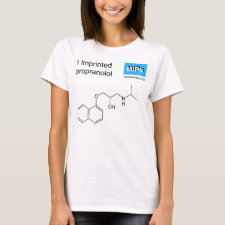
Authors: Yang KG, Berg MM, Zhao CS, Ye L
Article Title: One-Pot Synthesis of Hydrophilic Molecularly Imprinted Nanoparticles.
Publication date: 2009
Journal: Macromolecules
Volume: 42
Issue: (22)
Page numbers: 8739-8746.
DOI: 10.1021/ma901761z
Abstract: Molecularly imprinted nanoparticles were prepared using a simple distillation precipitation polymerization method. In this work, propranolol-imprinted nanoparticles were synthesized using different cross-linkers combined with methacrylic acid (MAA) as a functional monomer in refluxing acetonitrile. Using the new synthetic method, uniform prorpanolol-imprinted nanoparticles were obtained in less than 3 h, which is in contrast to the long reaction time (24 h) required in previous precipitation polymerization. The new synthetic method also provides a convenient means to prepare core-shell structured nanoparticles, where the core contains imprinted binding sites and the shell has more hydrophilic characteristics. Molecular recognition properties of the imprinted nanoparticles were studied through equilibrium binding experiments. For nanoparticles containing N,N'-methylenebis(acrylamide) cross-linker, the residual C-C bonds remaining in the nanoparticles were utilized to immobilize a fluorescent compound, 1-pyrenemethylamine, through nondestructive Michael addition reaction. The fluorescent modification did not deteriorate the molecular recognition property of the nanoparticles, suggesting that the Michael addition reaction took place only in nonselective sites. Using a similar Michael addition reaction, we anticipate that the residual C-C bonds in the acrylamide moiety can be utilized to introduce other reporter molecules into molecularly imprinted nanoparticles or to immobilize such nanoparticles on amine- or thiol-functionalized surfaces to develop different chemical sensors. The hydrophilic shell of the imprinted core-shell nanoparticles shall provide effective screening to prevent nonspecific adsorption of, e.g., proteins while allowing small target molecules to enter the imprinted sites in the more hydrophobic core, thereby potentially useful for extraction of small organic molecules from complex biological samples
Template and target information: propranolol



Join the Society for Molecular Imprinting

New items RSS feed
Sign-up for e-mail updates:
Choose between receiving an occasional newsletter or more frequent e-mail alerts.
Click here to go to the sign-up page.
Is your name elemental or peptidic? Enter your name and find out by clicking either of the buttons below!
Other products you may like:
 MIPdatabase
MIPdatabase









